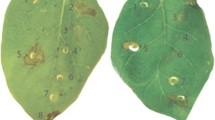Abstract
A DNA fragment (ADG2, 310 bp) 77% homologous to the gene N (resistance to tobacco mosaic virus in Nicotiana glutinosa) and 53% homologous to RPP5 (resistance to Peronospora parasitica in Arabidopsis thaliana) was amplified by PCR from the diploid potato genotype 2x(v-2)7 that carries the gene Ry adg located on chromosome XI and conferring extreme resistance to potato virus Y(PVY). Sequence comparison revealed that ADG2 spans a region corresponding to the predicted kinase-2 and kinase-3a motifs in N and RPP5. One of the 12 nucleotide differences detected between ADG2 and a homologous fragment from a PVY-susceptible potato genotype was located within the predicted kinase-3a motif. This single nucleotide substitution of G→C, resulting in an amino-acid substitution Ser→Thr, abolished the BbvI recognition site of ADG2, which was shown to distinguish all tested potato genotypes carrying Ry adg from those lacking this gene, irrespective of the genetic background and ploidy level. This PCR-based resistance marker, developed using a resistance gene analogue as a target, is the first example of a PCR-based marker that is generally applicable for selection of an economically important trait in potato.
Similar content being viewed by others
Author information
Authors and Affiliations
Additional information
Received: 28 November 1998 / Accepted: 28 December 1998
Rights and permissions
About this article
Cite this article
Sorri, V., Watanabe, K. & Valkonen, J. Predicted kinase-3a motif of a resistance gene analogue as a unique marker for virus resistance. Theor Appl Genet 99, 164–170 (1999). https://doi.org/10.1007/s001220051221
Issue Date:
DOI: https://doi.org/10.1007/s001220051221




